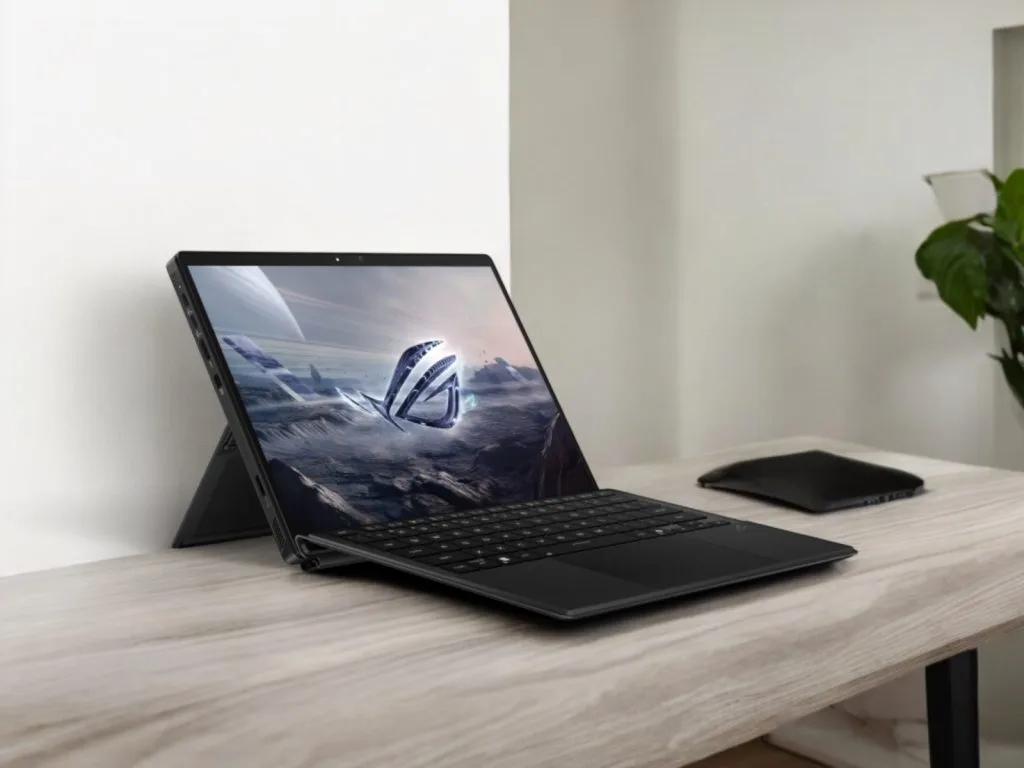The gaming world has seen plenty of innovative devices, but few have caught my attention like the Asus ROG Flow Z13 (2025).
After spending several weeks with this powerhouse, the combination of AMD’s revolutionary Ryzen AI Max+ 395 processor paired with Radeon 8060S graphics represents a significant leap in what integrated graphics can achieve.
Whether pushing through intensive benchmarks, gaming sessions, creative workloads, or AI tasks, the question remains – is this premium device worth its steep price tag?
Overview and Specifications
The moment of unboxing the ROG Flow Z13 reveals Asus’s attention to detail, with premium packaging setting expectations high before even powering on the device.
Opening the multi-layered box feels like unwrapping a premium product, with everything neatly organized and protected.
Some regions include additional bonuses – certain models ship with the Asus Pen stylus and a protective sleeve or laptop bag, though these inclusions vary by market.
The review unit features the AMD Ryzen AI Max+ 395 processor with 16 cores, 32 threads, and massive 80MB cache, paired with Radeon 8060S graphics featuring 40 compute units – essentially AMD’s new Strix Halo APU that combines high-performance CPU and GPU on a single chip.
An unexpected inclusion with some models is an accidental protection plan covering drops, breaks or spills for up to a year – something rarely bundled with devices in this category.
The specs of this test unit include:
- AMD Ryzen AI Max+ 395 processor (3.0GHz base, up to 5.1GHz boost)
- Radeon 8060S integrated graphics with 50 GPU compute units
- 32GB LPDDR5X-8000 memory (unified with adjustable allocation to GPU)
- 1TB PCIe 4.0 NVMe SSD (2230 form factor)
- 13.4-inch (34.0 cm) 2.5K (2560 x 1600) 180Hz touchscreen with 100% DCI-P3
- 70Wh battery (25% larger than previous gen)
- Wi-Fi 7 and Bluetooth 5.4
- Windows 11 Home
What stands out immediately is how AMD has created something truly revolutionary with this chip, delivering desktop-class performance in a tablet form factor through the integration of a 16-core CPU with a 40-core GPU on a unified memory architecture.
Design and Build Quality
The Z13’s all-metal construction feels substantial and premium to the touch, with impeccable machining revealing no sharp corners or unfinished sections.
This build quality comes from the CNC-milled aluminum unibody that maintains structural integrity while staying surprisingly light – you can truly feel the difference compared to cheaper plastic chassis designs.
Particularly impressive is the sturdy metal kickstand on the back with its heavy-duty hinges, allowing screen angle adjustments up to 170 degrees for incredible flexibility whether typing on a desk or using it on your lap.
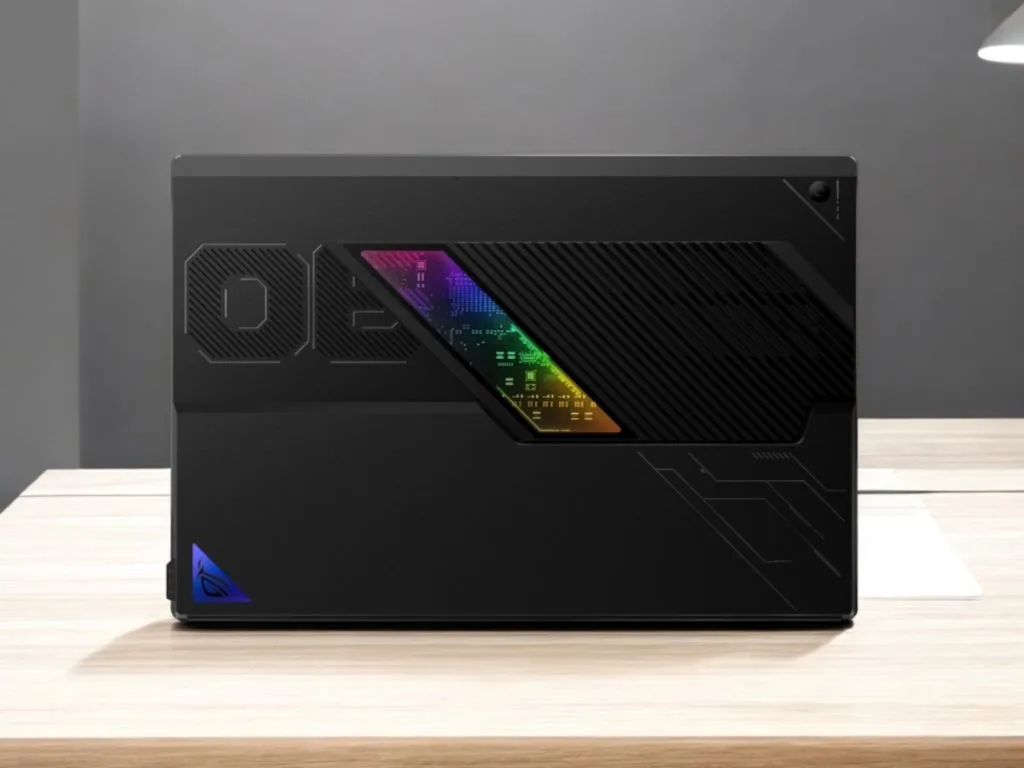
Gamer flair comes through the RGB lighting on the back window – adding personality without being overwhelming, with lighting subtle enough for professional settings when using the right color profile.
The rear RGB window can be fully customized through Armoury Crate software with various effects, and you can even set it to remain lit when the device is asleep or turn off when on battery power to save energy.
One quirk worth noting is how the kickstand mechanism can accidentally close when sliding the device back on a desk – something to be mindful of when transitioning from a conventional laptop.
The detachable keyboard connects via pins and snaps on securely with magnets, feeling higher quality than previous Z13 generations, though there’s still some flex when typing compared to a traditional laptop.
When folded, the keyboard doubles as a screen protector during travel – a clever dual-purpose design that proves really useful when tossing the device in a bag.
Portability
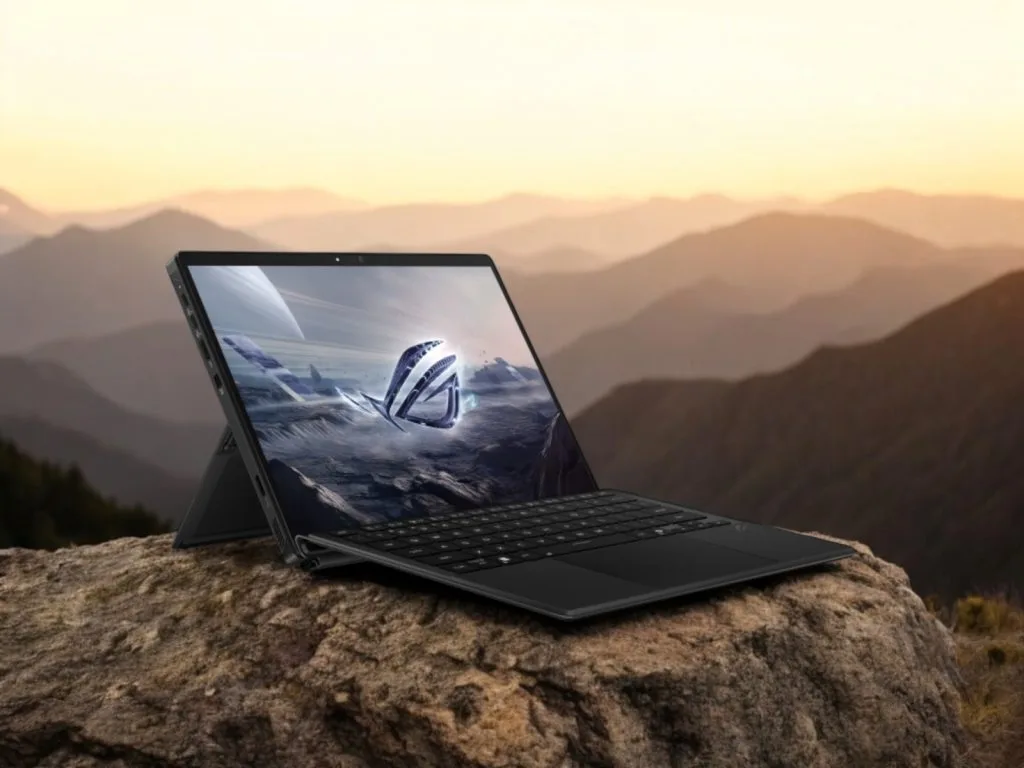
Weighing just 3.6 pounds (1.6kg) with the keyboard attached or 2.6 pounds (1.2kg) for the tablet alone, the Z13 is impressively portable for the power it packs.
Adding the 200-watt charger brings the total package to about 4.9 pounds (2.2kg), and surprisingly, it’s not actually the lightest device in comparison – both the Asus Zephyrus G14 and TUF A14 are slightly lighter with their keyboard attached.
The thickness compares to a high-end smartphone – roughly the same as an iPhone – making it incredibly easy to slip into a bag without taking up much space.
For travelers, the Z13’s form factor offers unique advantages – the kickstand works perfectly on airplane tray tables, and the tablet mode is ideal for consuming content during flights.
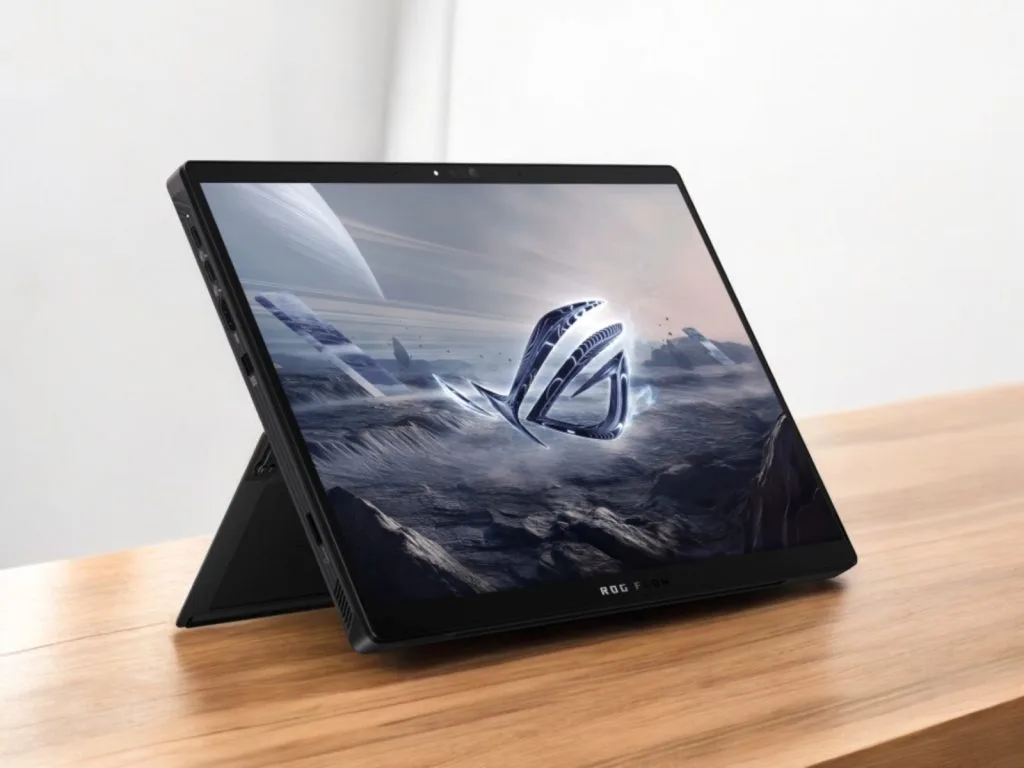
Display Quality
The 13.4-inch (34.0 cm) touchscreen on the Z13 stands out as a daily highlight, providing a taller, more productivity-friendly canvas than standard 16:9 displays with its 2560 x 1600 resolution (2.5K) and 16:10 aspect ratio.
As part of Asus’s premium ROG Nebula display line, this panel delivers 100% DCI-P3 color coverage, making it suitable for serious photo and video editing.
Games look incredibly smooth thanks to the 180Hz refresh rate (up from 165Hz in the previous generation) with Adaptive Sync, eliminating screen tearing without the performance hit of traditional V-sync.
Brightness testing showed the panel reaching just over 500 nits at maximum – sufficient for most indoor use, though some reflections from the glossy surface become noticeable near windows with direct sunlight.
While Pantone validated out of the box, color accuracy testing revealed the Delta E wasn’t perfect initially, but improved significantly after calibration.
Response time testing revealed a respectable 3.6ms average gray-to-gray transition with panel overdrive enabled – excellent for an IPS display and noticeably faster than the original Z13 from three years ago, though not quite matching the near-instantaneous response of OLED panels.
Panel overdrive is enabled by default in Armoury Crate, which significantly improves motion clarity without introducing noticeable artifacts – a welcome feature for both gaming and video playback.
Backlight bleed was only minor in testing, with small patches visible in completely dark environments, but these weren’t noticeable during normal usage with mixed content.
The total system latency in Counter-Strike 2 testing (measuring time between mouse click and on-screen action) was reasonable though not class-leading, with competing gaming laptops sometimes offering faster response times.
Keyboard, Touchpad, and Inputs
The chiclet keyboard features 1-zone RGB backlighting controlled through the Armoury Crate software, with all keys and secondary functions illuminated, though the backlighting appears somewhat dim even at the highest of three brightness levels.
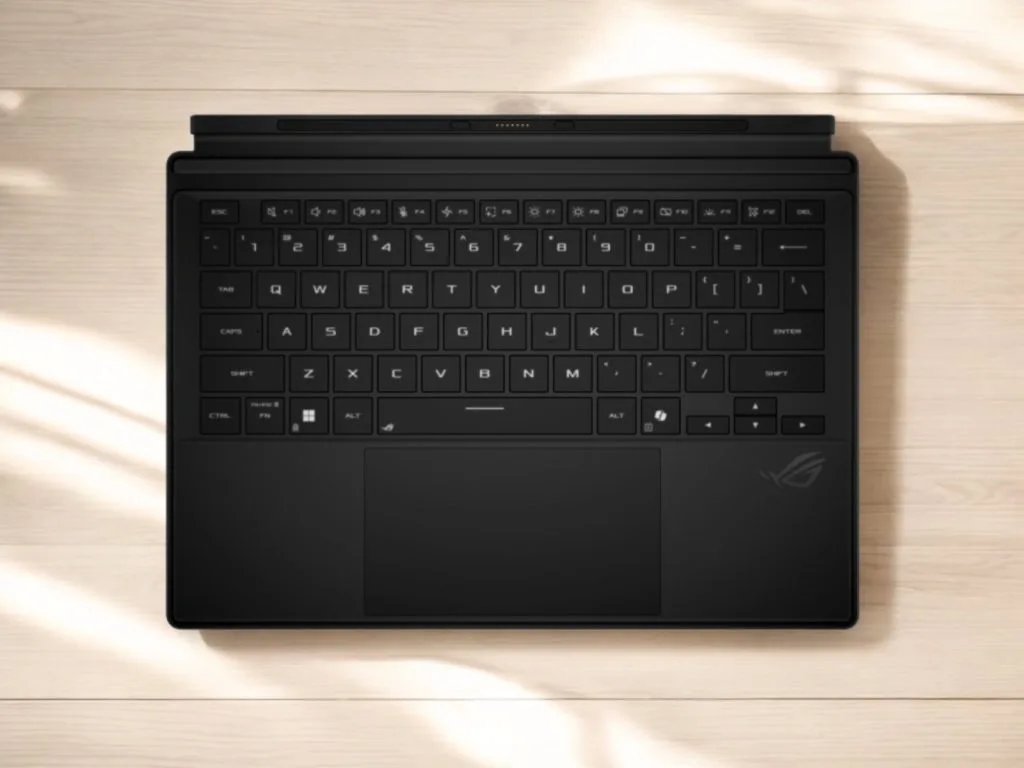
Typing feels good but not great, with that slight flex mentioned earlier and keys having a somewhat mushier feel than a premium laptop keyboard.
Key spacing feels comfortable, allowing for maintaining usual typing speed after a brief adjustment period, with decent travel distance considering the thin profile of the keyboard cover.
The touchpad has been enlarged from previous generations and offers a smooth glass-like surface with a satisfying click mechanism, though pressing towards the top portion reveals some flex that can be eliminated by laying the keyboard flat.
The touch screen works flawlessly as an input method, often becoming the instinctive choice especially in tablet mode, and while a stylus isn’t included in the box for this configuration, the display is fully stylus-compatible.
The Command Center button on the side of the device brings up convenient touch-friendly controls when in tablet mode, making it easier to adjust performance profiles, take screenshots, or access other system functions without the keyboard attached.
Ports and Connectivity
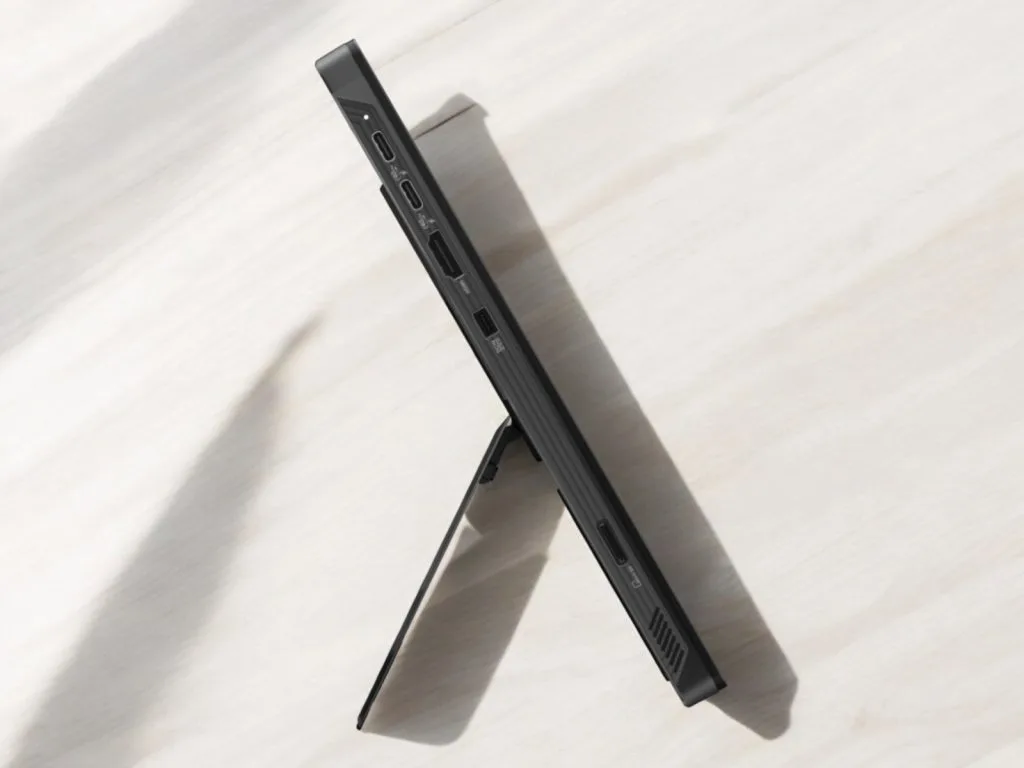
For a device this compact, the variety of ports is impressive, with the left side featuring two USB 4 Type-C ports with DisplayPort 2.1 and power delivery support, a full-size HDMI 2.1 port, the rectangular power connector, and a UHS-II MicroSD card slot.
The right side houses a USB 3.2 Gen 2 Type-A port and a 3.5mm audio combo jack, along with the power button which, unlike the original Z13, doesn’t include a fingerprint scanner.
Both Type-C ports support charging up to 100 watts and can run external displays, with testing confirming the HDMI port successfully ran a 4K TV at 120Hz with 12-bit color depth.
Wireless connectivity comes via Wi-Fi 7 – the latest standard – delivering decent speeds of around 2 gigabits, though the MediaTek chip doesn’t quite match the throughput of Intel or Killer options in competing laptops.
The MicroSD card reader delivers excellent transfer speeds rivaling external readers, with the card sitting fully inside the machine without protruding, though inserting and removing cards feels slightly awkward even with longer fingernails.
Testing confirmed the USB4 ports operate at the full 40Gbps bandwidth, making them suitable for high-speed storage devices or eGPUs, though the lack of Thunderbolt 5 (which would offer 80Gbps) may limit future eGPU performance.
eGPU users should note that while the Z13 works with external graphics enclosures, the 40Gbps bandwidth limitation means high-end cards like RTX 4080/4090 may be bottlenecked, with users reporting approximately 10-20% performance loss compared to the same card in a desktop.
Memory and Storage
One of the most fascinating aspects of the Z13 is its RAM configuration, with 32GB (or optionally 64GB/128GB) of LPDDR5X-8000 memory on-package with the CPU and GPU, meaning no post-purchase upgrades are possible.
Experimenting with different allocations on the 32GB model revealed 8GB of VRAM and 24GB of system memory provided the best balance for most workloads, though memory-intensive games benefited from bumping up to 16GB VRAM when needed.
The 128GB model can allocate up to 96GB to graphics – an astonishing amount of VRAM that opens possibilities for local AI workloads typically requiring a high-end desktop GPU.
The default VRAM allocation comes set to just 4GB, which can limit gaming performance until manually changed – a small oversight in an otherwise well-thought-out system.
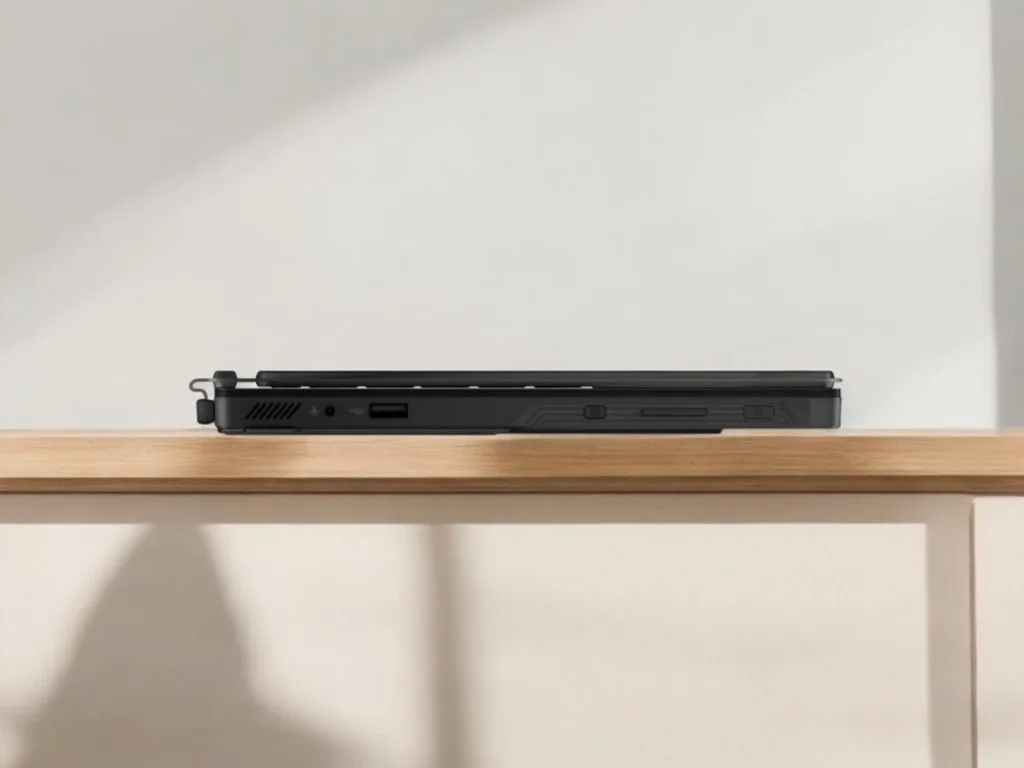
The LPDDR5X-8000 memory runs in quad-channel configuration with extremely low timings – among the lowest seen in a portable device – providing exceptional bandwidth for both CPU and GPU operations.
For storage, the Z13 includes a 1TB PCIe Gen 4 NVMe SSD in the 2230 (shorter) form factor – the only upgradeable internal component, accessible behind a small metal hatch secured by a single TR5 screw behind the kickstand.
The included drive delivers excellent read/write speeds, but the upgrade path feels somewhat limited due to the 2230 size restriction and the fact that it’s the only storage slot available.
2230 SSDs currently max out at about 2TB capacity, which may be limiting for users with large game libraries or media collections, though the fast microSD slot provides a secondary storage option.
Performance: Processor and Graphics
The star of the show is undoubtedly AMD’s Ryzen AI Max+ 395 processor paired with the Radeon 8060S graphics – together forming what AMD calls the “Strix Halo” APU that redefines what integrated graphics can accomplish.
CPU benchmarking reveals shocking results, especially in multi-core workloads, with Cinebench R24 scores surpassing several much larger 18-inch (45.7 cm) gaming laptops equipped with dedicated GPUs.
While Intel-based laptops maintain a slight edge in single-core performance, the multi-core capabilities are astounding for a device this size, maintaining impressive performance even when running on battery power alone.
Graphics-wise, the Radeon 8060S with its 40 compute units delivers performance comparable to a mobile RTX 4060 or 4070 (depending on the game and power limits) – an unprecedented achievement for integrated graphics that transforms the Z13 into a legitimate gaming machine.
3DMark FireStrike testing showed performance matching or exceeding laptops with dedicated GPUs – a genuinely surprising result given the thermal constraints of the tablet form factor.
The FireStrike GPU score for the Z13 in manual mode reached impressive levels, with the system delivering over 50 FPS at just 1.9 FPS per watt – significantly more efficient than competing solutions.
Perhaps most impressive is the efficiency, with Silent mode at around 35 watts still delivering very playable framerates in most games while maintaining reasonable temperatures and near-silent operation.
Performance Modes
Asus’s Armoury Crate software provides several performance profiles: Silent, Performance, Turbo, and Manual, each increasing the power limits and fan speeds accordingly.
Silent mode operates between 25-35 watts and prioritizes quiet operation, with fan noise barely audible at around 36 dB, making it perfect for productivity in quiet environments.
Performance mode increases power limits to around 45-70 watts, balancing noise and capability for daily use and moderate gaming with fan noise around 42-45 dB.
Turbo mode pushes the system to 60-90 watts with more aggressive fan curves, sacrificing some acoustic comfort for maximum stock performance.
Manual mode with maxed settings allows the system to sustain 85 watts of combined CPU and GPU power – remarkable for a device this thin – though fan noise becomes more pronounced at around 50 dB.
One quirk encountered during testing was occasional performance instability in games, with sudden drops to around 20 FPS sometimes persisting until reboot, occasionally requiring multiple restarts to resolve – suggesting a possible power management or driver issue.
Gaming Performance
The Z13 proves its gaming credentials across numerous titles, marking the first integrated graphics solution capable of handling modern AAA games at 1440p with good settings.
Cyberpunk 2077 at 1080p with high settings delivers framerates slightly ahead of systems with AMD’s 6800M discrete graphics from a few years back, performing just behind RTX 4060 laptops but ahead of lower-powered RTX 4070 models.
The 1% low framerates often exceed competing systems, likely thanks to the massive 80MB cache on the Ryzen AI Max+ 395 processor, translating to fewer stutters and a smoother overall experience.
Control, a GPU-intensive title typically favoring NVIDIA hardware, runs impressively well at 1440p, maintaining framerates just under 60 FPS and matching performance of RTX 3060 or lower-powered RTX 4060 laptops.
Call of Duty Black Ops 6 reaches around 120 FPS at 1200p with optimized settings, delivering remarkably consistent frame times even in demanding multiplayer scenarios.
Latency testing in Black Ops 6 showed the Z13 averaging around 6-7ms combined CPU and GPU latency, outperforming even high-end gaming laptops that typically measured 8ms or higher – contributing to a more responsive gaming experience.
Monster Hunter Wilds at 1440p with FSR and Frame Generation enabled delivers a very playable 102 FPS average – impressive for any mobile system, let alone integrated graphics.
Forza Motorsport, another demanding racing title, maintained 78 FPS at 1600p with medium settings, though performance varied based on power modes, with silent mode still delivering a very playable experience around 50-60 FPS.
Gaming on battery power works surprisingly well for less demanding titles, though lengthy AAA gaming sessions will drain the battery fairly quickly under load.
Using a 100W USB-C charger instead of the included 200W brick still allows for decent gaming performance, falling between Performance and Turbo modes, though the battery slowly drains during intensive gaming, making it less suitable for extended sessions.
Radeon 8060S vs RTX 4060 laptop GPU
Extensive testing across dozens of titles reveals a fascinating picture when pitting this Radeon 8060S directly against a dedicated RTX 4060 laptop GPU.
While the discrete RTX 4060 generally maintains an edge, particularly with ray tracing enabled, the integrated 8060S performs remarkably closely in many scenarios and even takes the lead in some demanding games.
Ultimately, the choice between integrated power like this and a traditional discrete GPU involves balancing raw gaming frame rates against factors like CPU strength, portability, and overall system cost.
For a deep dive into how these two solutions stack up across 25 different games at 1080p and 1440p, check out the detailed comparison right here.
To see how this plays out across a wide range of titles, the chart below visualizes the performance difference between the NVIDIA RTX 4060 and the AMD Radeon 8060S in 24 games tested at 1080p.
It shows the percentage by which the RTX 4060 leads (positive values, right side) or trails (negative values, left side) the Radeon 8060S in average FPS for each game.
Creative Work Performance
Content creators will find a lot to love about the Z13, particularly with its color-accurate display and strong processing capabilities.
Video Editing Performance
Adobe Premiere Pro handles various video formats impressively, with 4K H.264 video working at full quality with minimal to no dropped frames when plugged in, and only 6 drop frames in a 45-second timeline on battery power in silent mode – entirely usable for on-the-go editing.
H.265 10-bit 4:2:2 footage from a Sony A7S III plays back flawlessly at full quality even on battery power – surprising performance considering this codec’s typical demands on processing power.
More challenging 120fps footage requires quarter resolution for smooth playback on battery, upgrading to half resolution when plugged in – still very workable for most editing tasks.
Export times impress with their speed, as a 9-minute 4K clip renders to YouTube settings in just 2 minutes and 36 seconds while unplugged – faster than many laptops with dedicated GPUs.
For 6K footage, both RED and Blackmagic RAW files perform admirably, with half-quality playback of 6K BRAW showing just 4 dropped frames after a full minute of playback on battery power.
RED 6K footage demands more resources, requiring quarter resolution for smooth playback on battery, but this still represents impressive capability for a tablet-format device running unplugged.
In DaVinci Resolve benchmarks, the Z13 performed exceptionally well, scoring just behind laptops with dedicated RTX 4070 GPUs and significantly outperforming machines with RTX 4050/4060 cards.
Photo Editing Performance
Adobe Photoshop ranks the Z13 among the fastest devices tested, with benchmark scores exceeded only by larger workstations featuring higher-end components.
AI-powered features like the new Denoise tool in both Photoshop and Lightroom Classic complete in approximately 10 seconds when plugged in and 18-20 seconds on battery power – very competitive performance.
Comparatively, older laptops with dedicated GPUs often took 50+ seconds for the same AI denoise operations, showing the advantage of the AMD architecture with its integrated NPU for AI acceleration.
Importing 100 RAW files into Lightroom takes around 29.5 seconds, longer than some competing laptops but entirely reasonable for a device of this size.
The color-accurate display truly enhances photo editing work, while the touchscreen makes masking and brush work much more intuitive than using a mouse or trackpad.
AI Performance
The Z13 combines three AI acceleration components: powerful CPU cores, GPU compute units, and AMD’s XDNA2 NPU rated at up to 50 TOPS, creating a capable platform for on-device AI workloads.
Large language models (LLMs) like Llama run locally with responsive performance, benefiting from the ability to allocate substantial VRAM to the GPU (up to 24GB on the 32GB model) – enabling larger models than most laptops can handle.
Image generation through AMD’s Amuse software with stable diffusion models utilizes all three processing components – CPU, GPU, and NPU – for efficient, high-quality output.
The XDNA2 NPU acceleration particularly shines in super-resolution tasks, noticeably improving image quality while maintaining reasonable generation times.
Video generation through AI transformation of existing footage performs well, especially with lower resolution and frame count settings, though remains time-consuming as with any system.
Geekbench AI benchmarks show impressive results, especially in tasks leveraging the NPU, further enhanced by the unified memory architecture with extremely fast LPDDR5X-8000 RAM that benefits AI workloads requiring rapid memory access.
The integrated XDNA2 NPU can deliver up to 50 TOPS (Trillion Operations Per Second) of AI compute, making it suitable for local AI inferencing tasks without relying on cloud services.
Thermals and Noise
Thermal management proves critical for this high-performance device in such a compact chassis, with Asus implementing clever cooling solutions including two fans with a vapor chamber cooler and liquid metal thermal interface.
The intake vents positioned on the back panel allow for better airflow compared to traditional laptops where intakes are often pressed against surfaces, helping maintain temperatures around 80°C even under maximum load – impressive considering the power being generated in such a small space.
Fan noise remains completely silent at idle, increasing predictably with each higher performance mode, with Manual mode at maximum settings being fairly loud but representing a worst-case scenario.
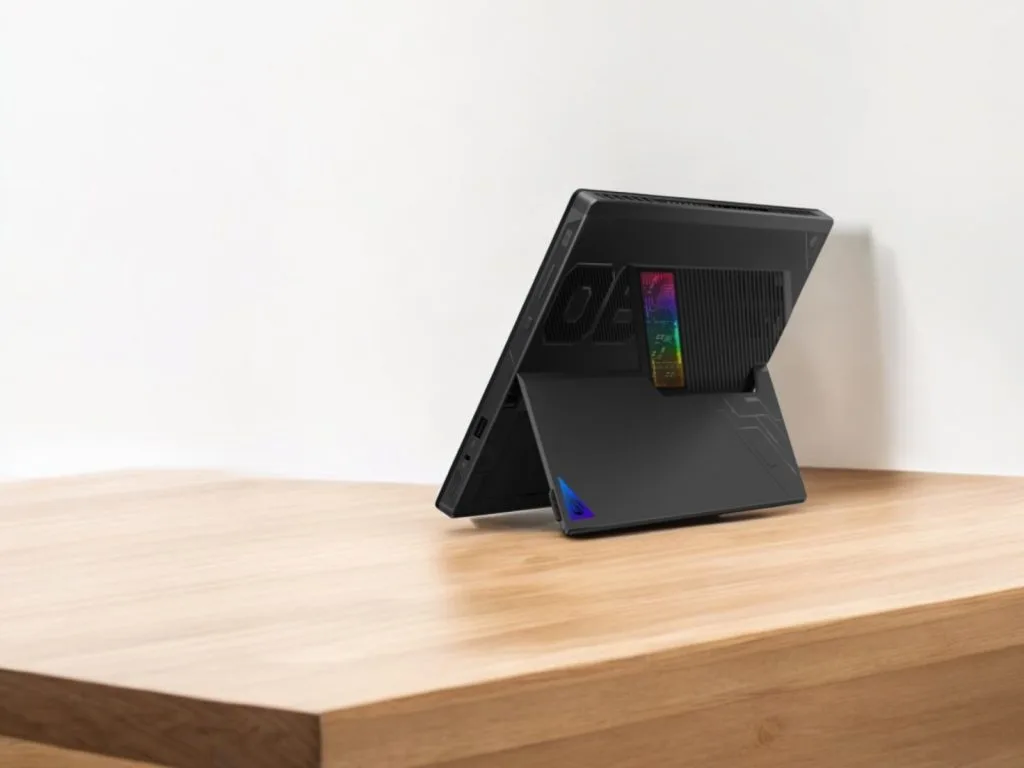
Performance mode strikes the best balance, offering reasonable noise levels while still delivering excellent performance, while Silent mode stays remarkably quiet yet provides enough cooling for productivity tasks and lighter games.
One benefit of the tablet design becomes immediately apparent in how the keyboard never gets hot during intensive tasks, as there are no heat-generating components beneath it, resulting in one of the coolest keyboard hot spots measured in years of testing.
The glass touchscreen can get slightly warm during extended gaming sessions, but never reaches uncomfortable temperature levels.
Unlike traditional gaming laptops that can reach uncomfortable temperatures of 50°C+ on the keyboard deck, the Z13’s unique design means your hands remain cool during extended gaming or rendering sessions.
The exhausts located at the top of the tablet direct hot air away from the user, another ergonomic advantage over conventional laptop designs where hot air often blows onto the user’s mouse hand.
Battery Life
The Z13 houses a 4-cell 70Wh battery, 25% larger than the previous generation, complemented by power-saving features including a panel power saver that automatically reduces screen refresh rate to 60Hz when unplugged.
YouTube video playback testing shows the Z13 lasting nearly 9 hours – excellent for a device with this much processing power, while gaming on battery predictably reduces this to about 2 hours, still respectable given the performance level.
Lighter workloads like document editing or web browsing consistently deliver 8-10 hours of use with reasonable screen brightness, potentially extending further with more aggressive power saving settings and reduced brightness, comparable to some competitors.
Optimizing power settings for indie games or lightweight titles yields impressive results, with Stardew Valley running at just 6 watts for an estimated battery life exceeding 7 hours.
The included 200W charger provides rapid charging, but the Z13 also supports USB-C charging up to 100W, allowing travel with a smaller GaN charger or even a power bank to extend time away from outlets.
During testing with a 100W USB-C charger in Performance mode, the Z13 still performed admirably, with only a 5% battery drain after 10 minutes of gaming – indicating that for most productivity tasks, a smaller charger would be entirely sufficient.
For airplane use, the Z13 works well with typical seat power outputs of 70-100W, allowing for productive use throughout even long-haul flights without battery anxiety.
Speakers, Camera and Microphones
The Z13 features speakers on both left and right sides towards the bottom, delivering reasonably loud output but somewhat thin sound with limited bass response – typical limitations for ultra-portable devices.
Technical specifications list them as 2W dual-force speakers with Smart Amp Technology and Dolby Atmos support, which enhances spatial audio perception, though physics remains the limiting factor for these small drivers.
For serious gaming or media consumption, headphones are definitely recommended, though the speakers are adequate for casual video watching and conference calls.
The camera setup exceeds typical laptop offerings, featuring a 5MP front-facing camera with IR for Windows Hello face authentication, complemented by a 13MP rear camera – an unusual but welcome addition for a laptop-class device.
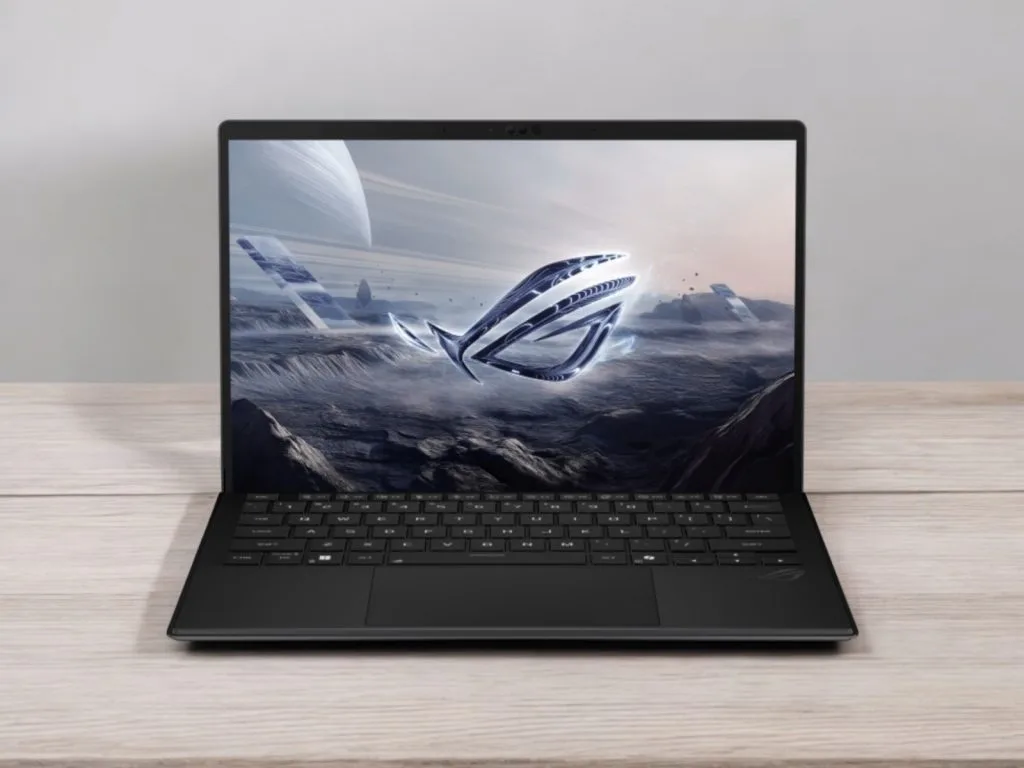
Resolution options impress with the front camera recording at 1440p and the rear camera supporting 4K, both delivering surprisingly good image quality in adequate lighting conditions.
The microphone array captures voice clearly, enhanced by effective AI noise cancellation that effectively reduces background sounds, isolating speech even in noisy environments.
Testing showed a dramatic difference between audio with and without AI noise cancellation, making this feature particularly valuable for video conferencing in less-than-ideal acoustic environments.
Software and User Experience
The Z13 comes with Windows 11 and Asus’s typical software suite, primarily centered around Armoury Crate for controlling performance profiles, lighting, GPU memory allocation, and various system settings.
While Armoury Crate might seem bloated to some users, the centralized control over key system features proves valuable, with a reasonably intuitive interface and useful monitoring tools for temperatures, clock speeds, and resource usage.
The additional Command Center button on the side brings up helpful shortcuts when operating in tablet mode without the keyboard attached – a thoughtful touch that enhances the tablet experience.
An annoyingly loud boot sound plays by default, though this can be easily disabled through Armoury Crate or the BIOS.
Linux compatibility testing with Ubuntu 24.10 via live USB shows basic functionality working out of the box, including keyboard, touchpad, touchscreen, Wi-Fi, and the front camera, while speakers, Bluetooth, screen brightness controls, and the rear camera remained non-functional – expected limitations with very new hardware that should improve with future updates.
Some models ship with a 3-month Xbox Game Pass subscription included, adding value for gamers looking to explore Microsoft’s extensive game library.
The MyASUS software provides additional utilities including display color profile selection, with preset profiles for DCI-P3, Adobe RGB, sRGB, and other color spaces – particularly useful for creative professionals who need accurate color representation.
Upgradeability and Repair
The Z13’s compact design significantly limits upgradeability, with the only user-replaceable component being the M.2 2230 SSD, accessible via a small hatch secured by a single screw behind the kickstand.
RAM cannot be upgraded since it’s integrated with the processor package, making the initial configuration choice critical – if more RAM might be needed later, investing in a higher-capacity model upfront becomes the only option.
The 2230 form factor for the SSD presents certain limitations, being shorter than the more common 2280 drives, with fewer options available and typically higher costs per gigabyte than larger counterparts.
The microSD card slot can serve as semi-permanent storage expansion, though with lower performance than the internal SSD, with a high-capacity UHS-II card providing a reasonable secondary storage option.
Some users on Reddit have mentioned exploring external SSD options, including magnetically attached 2230 enclosures or using the USB4 ports for high-speed external storage as workarounds for the internal storage limitations.
Comparisons
Comparing the Z13 to traditional gaming laptops with dedicated GPUs reveals comparable performance in a much more versatile form factor, though at a premium price, with standard RTX 4060 or 4070 laptops typically delivering better raw gaming performance per dollar.
Versus the ROG Ally X or other gaming handhelds, the Z13 provides a significantly larger screen, better keyboard experience, and substantially more processing power, trading some portability for these advantages.
When matched against productivity-focused tablets like the Microsoft Surface Pro, the Z13 offers dramatically better performance and gaming capabilities, though with slightly more weight and less battery life for light tasks.
Compared to previous Z13 models, the 2025 version represents a significant upgrade in nearly every aspect – better CPU performance, dramatically improved graphics, longer battery life, and a more refined build.
For those considering streaming games from the Z13 to a handheld device, Reddit users report excellent experiences using the Z13 as a host machine for streaming to devices like the ROG Ally, providing desktop-class performance on a handheld with good battery life.
Pros and Cons
Pros
- Exceptional CPU performance that rivals or exceeds many larger gaming laptops
- Surprisingly powerful integrated graphics comparable to mid-range dedicated GPUs
- Versatile form factor that works as both laptop and tablet
- High-quality 180Hz touchscreen with 100% DCI-P3 coverage
- Solid build quality with premium materials
- Good port selection including USB 4 and HDMI 2.1
- Impressive battery life for the performance class
- Advanced cooling system keeps temperatures in check
- Flexible memory allocation between system and GPU
- Wi-Fi 7 support for future-proof connectivity
Cons
- Very expensive compared to traditional gaming laptops with similar performance
- Limited upgradeability with only the 2230 SSD being replaceable
- Non-upgradeable RAM makes choosing the right configuration crucial
- Occasional performance instability in some games requiring reboots
- Mediocre speaker quality
- Touchpad reliability issues (may be unit-specific)
- Limited Linux compatibility (at least at launch)
Who Should Buy the ROG Flow Z13 (2025)?
After extensive testing, the ROG Flow Z13 (2025) proves ideal for:
- Creative professionals who travel frequently – The combination of processing power, color-accurate display, and tablet functionality makes it perfect for on-the-go photo and video editing.
- Gamers who prioritize versatility and form factor – If you value the ability to game in different environments and configurations over absolute maximum performance per dollar.
- Power users who want an all-in-one device – The Z13 can effectively replace a gaming laptop, productivity laptop, and entertainment tablet in one device.
- AI enthusiasts interested in local model development – The higher RAM models with adjustable VRAM allocation provide unique capabilities for running AI workloads locally.
- Early adopters who want cutting-edge technology – The revolutionary Strix Halo APU represents a significant shift in integrated graphics capability.
Who Should Look Elsewhere
- Budget-conscious gamers – Traditional gaming laptops offer better performance per dollar if versatility isn’t a priority.
- Those who prioritize the lightest possible device – While portable, the Z13 is still heavier than ultralight productivity laptops.
- Users who need maximum upgradeability – The limited upgrade options mean you need to buy the right configuration upfront.
- Those who require the absolute highest gaming performance – High-end gaming laptops with RTX 4080/4090 GPUs will outperform the Z13, especially at higher resolutions.
FAQ
How powerful is the ROG Flow Z13 Strix Halo?
The ROG Flow Z13 with AMD’s Strix Halo (Ryzen AI Max+ 395) delivers performance comparable to laptops with RTX 4060-4070 mobile GPUs for gaming, while its CPU performance can outmatch even some 18-inch gaming laptops in multi-core workloads.
It’s remarkably powerful for its size.
What is the battery life of the Flow Z13 2025?
Battery life varies by usage: approximately 9 hours for video playback, 2 hours for intensive gaming, and 8-9 hours for productivity tasks.
For lightweight games, you can optimize power settings to achieve 5-6 hours of gameplay.
Can the ROG Flow Z13 2025 run AAA games?
Yes, the Flow Z13 (2025) can run modern AAA games smoothly at 1080p high settings, and many titles at 1440p with good framerates.
Games like Cyberpunk 2077, Call of Duty, and Forza Horizon 5 run impressively well on this integrated graphics solution.
How much VRAM can the Flow Z13 2025 use?
The amount of VRAM depends on your model and configuration settings.
The 32GB model can allocate up to 24GB as VRAM, the 64GB model up to 48GB, and the 128GB model up to 96GB.
This is adjusted through Armoury Crate software and requires a reboot to apply.
Is the ROG Flow Z13 good for video editing?
Yes, the Flow Z13 is excellent for video editing. It handles 4K H.264/H.265 footage smoothly, can work with 6K RAW files at reduced resolution, and exports quickly.
The color-accurate display and strong multi-core performance make it well-suited for video production.
Does the Asus Flow Z13 2025 overheat?
No, despite its compact size, the Flow Z13 manages heat effectively with its vapor chamber cooling and liquid metal thermal interface.
Even under full load, temperatures typically hover around 80°C.
The tablet design with rear air intakes actually provides better airflow than many traditional laptops.
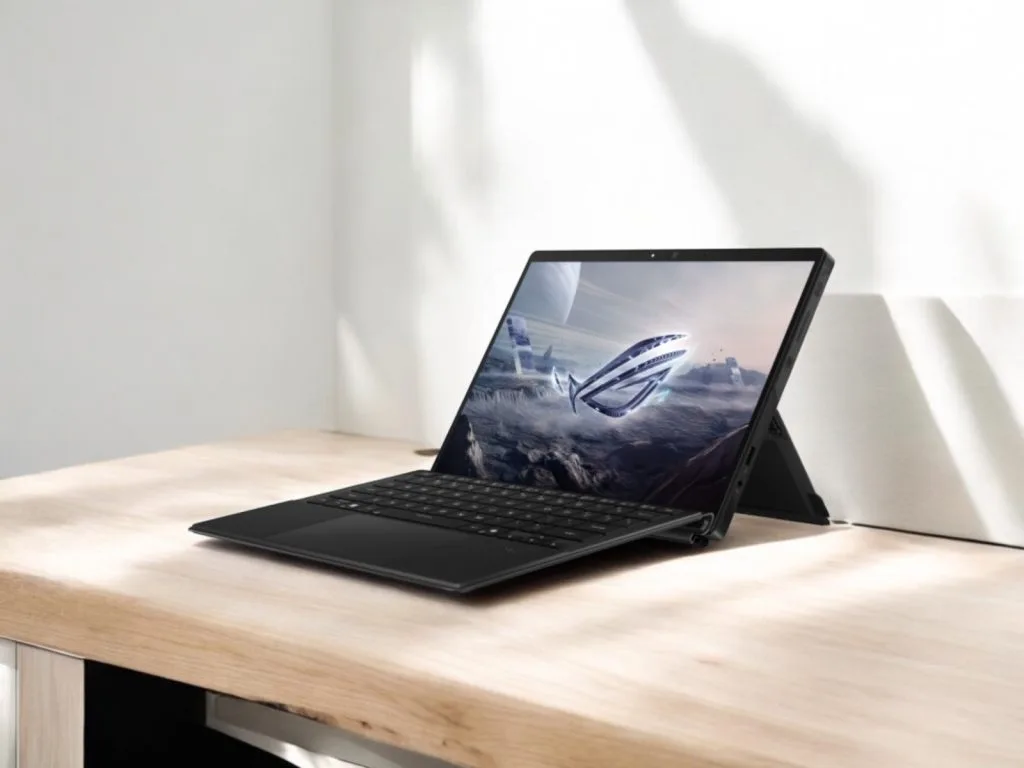
What ports does the Asus Flow Z13 2025 have?
The Flow Z13 (2025) includes two USB 4 Type-C ports with DisplayPort and power delivery, one USB 3.2 Gen 2 Type-A port, HDMI 2.1, a 3.5mm audio combo jack, a microSD card reader (UHS-II), and a proprietary power connector.
How does the Flow Z13 2025 compare to the ROG Ally X?
The Flow Z13 offers significantly more processing power, a larger 13.4-inch screen, and a detachable keyboard compared to the ROG Ally X.
The Ally X is more portable and has dedicated gaming controls, but the Z13 is more versatile as both a productivity device and gaming machine.
Can you upgrade the RAM on the ROG Flow Z13 2025?
No, the RAM is integrated on-package with the CPU/GPU and cannot be upgraded after purchase.
You must choose the right configuration (32GB, 64GB, or 128GB) when buying the device.
Is the ROG Flow Z13 2025 good for students?
The Flow Z13 can be excellent for students who need both creative/engineering application performance and gaming capabilities.
However, its high price point may be prohibitive for many students, and those primarily focused on note-taking and web browsing might find cheaper alternatives more appropriate.
Can the Flow Z13 be used on an airplane?
Yes, the Flow Z13 works well on airplanes. The kickstand makes it easy to use on tray tables, and it can operate with the typical 70-100W power output from airplane seats.
For flights without power outlets, the battery can last 4-5 hours for light gaming or 8-9 hours for productivity tasks.
What are the alternatives to the Asus Flow Z13?
Alternatives include traditional gaming laptops with dedicated GPUs (better performance per dollar), Microsoft Surface Pro models (better as tablets, weaker for gaming), the ROG Ally or Steam Deck (more portable but smaller screens), or the Asus Zephyrus G14 (similar performance in a traditional laptop form factor).
Conclusion
After weeks with the Asus ROG Flow Z13 (2025), the achievements of AMD and Asus are genuinely impressive, representing a significant leap forward for integrated graphics that challenges expectations of what’s possible in a tablet form factor.
The combination of desktop-class CPU performance and GPU capabilities rivaling mid-range dedicated graphics cards creates a truly versatile device handling everything from serious creative work to modern gaming in a form factor that works as both laptop and tablet.
This cutting-edge technology comes at a premium price that can’t be ignored, starting at $2,099 for the base model and climbing to $2,799 for the 128GB variant – an investment that could alternatively purchase multiple dedicated gaming laptops.
The value proposition ultimately depends on how much you prioritize the unique form factor and versatility, with traditional gaming laptops offering better pure gaming value but lacking the Z13’s ability to effectively replace multiple devices while delivering impressive performance across various tasks.
Most exciting is what the Strix Halo APU represents for computing’s future, potentially marking the beginning of the end for the clear distinction between integrated and dedicated graphics as this technology matures and becomes more accessible.
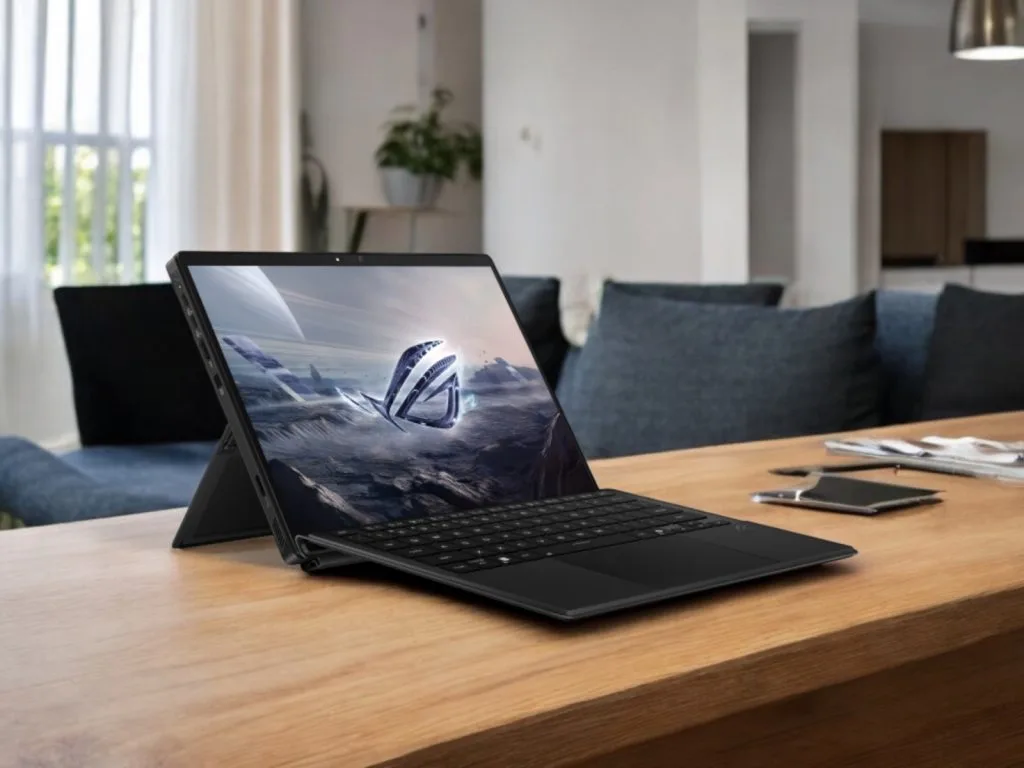
For now, the ROG Flow Z13 (2025) stands as an impressive showcase of engineering – a premium device for early adopters and those with specific needs that align with its unique capabilities, not for everyone, but potentially the ultimate all-in-one portable computing solution for the right user.


